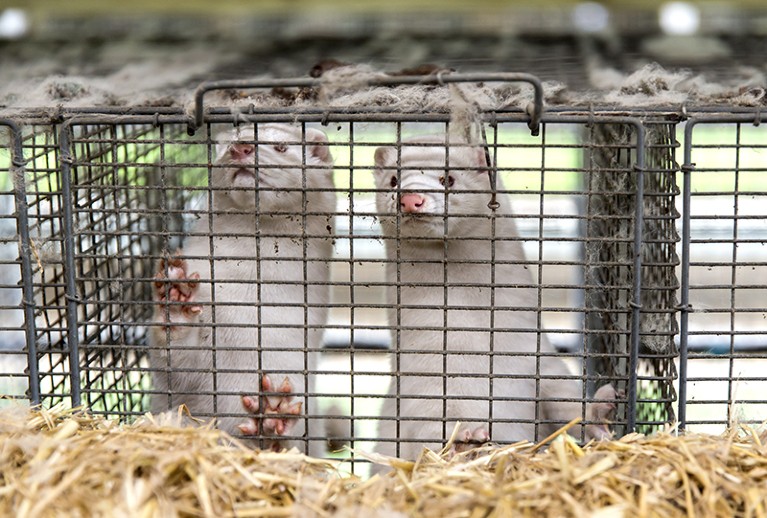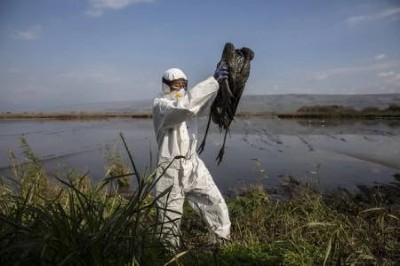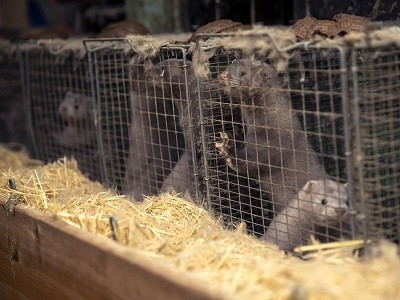
The new variant of H5N1 flu had been spreading among mink.Credit: Ole Jensen/Getty
An outbreak of avian influenza on a mink farm in Spain provides the strongest evidence so far that the H5N1 strain of flu can spread from one infected mammal to another.
The outbreak of H5N1 flu, described in a report in Eurosurveillance on 19 January1, occurred on an American mink (Neovison vison) farm in Carral in October 2022. Genetic sequencing showed that the animals were infected with a new variant of H5N1, which includes genetic material from a strain found in gulls, as well as a genetic change known to increase the ability of some animal-flu viruses to reproduce in mammals.
The new variant puts bird flu in “uncharted territory”, says Wendy Puryear, a virologist at Tufts University in Medford, Massachusetts. Researchers have warned that, without careful precautions, the disease might eventually spread among people.
Jumping species
Over the past year, H5N1 has shown an increasing ability to jump from birds to mammals. In the United States, infections have been found in about a dozen species, including raccoons, foxes, seals and grizzly bears.

Why unprecedented bird flu outbreaks sweeping the world are concerning scientists
Until this particular outbreak, all mammalian infections could be attributed to direct contact with virus-contaminated material, says Hualan Chen, a virologist at the Harbin Veterinary Research Institute in China. For example, animals that ingest wild-bird droppings, or that prey on infected animals, can develop the disease. But its spread between mammals “implies that this H5N1 virus may pose a higher risk to public health”, Chen says.
During the first week of October 2022, workers on the affected mink farm noticed that the minks’ mortality rate had increased from a baseline of 0.25% per week to 0.77%, prompting tests on the affected animals for the H5N1 and SARS-CoV-2 viruses. The animals tested positive for H5N1. In the following weeks, more animals fell sick, and the disease seemed to spread from ‘hot spots’ of between two and four pens, in which all animals became infected and died. Workers were forced to cull all 51,986 mink on the farm. Eleven farm workers were in contact with the infected mink, but all tested negative for H5N1.
“This species could serve as a potential mixing vessel for the interspecies transmission among birds, mammals and human,” the report’s authors write. “It is necessary to strengthen the culture of biosafety and biosecurity in this farming system and promote the implementation of ad hoc surveillance programs for influenza A viruses and other zoonotic pathogens.”
Preventing spread
Measures taken to prevent the new strain from spreading beyond the farm seem to have been “vigorous, comprehensive and successful”, says infectious-disease specialist William Schaffner at Vanderbilt University Medical Center in Nashville, Tennessee.

COVID mink analysis shows mutations are not dangerous — yet
But Puryear thinks that because the new variant contains genetic material from gull flu, it’s likely that at least some of its genetic changes arose in gulls before entering the mink farm. This means that a strain containing those mutations is probably still circulating in the bird population. But for human populations, the outlook is still good: if the new strain did start to infect people, health authorities could probably produce a vaccine quickly, and the antiviral drug Tamiflu can reduce the severity of the disease.
The potential risk to wild animals is greater. Bird flu has consistently caused high levels of sickness and death among wild birds and mammals over the past year, and how the new variant will affect that trend remains to be seen. “We just simply don’t know,” says Puryear.










![Best Weight Loss Supplements [2022-23] New Reports!](https://technologytangle.com/wp-content/uploads/2022/12/p1-1170962-1670840878.png)




